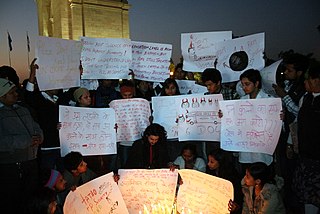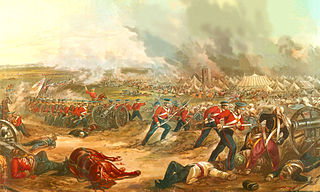
New Delhi is an urban district of Delhi which serves as the capital of India and seat of all three branches of the Government of India.

The First Anglo-Sikh War was fought between the Sikh Empire and the East India Company between 1845 and 1846. It resulted in partial subjugation of the Sikh kingdom and cession of Jammu and Kashmir as a separate princely state under British suzerainty.

Major General Sir Henry Tombs VC KCB was a recipient of the Victoria Cross, the highest and most prestigious award for gallantry in the face of the enemy that can be awarded to British and Commonwealth forces.

The Sikh Empire was a major power originating in the Indian subcontinent, formed under the leadership of Maharaja Ranjit Singh, who established a secular empire based in the Punjab. The empire existed from 1799, when Ranjit Singh captured Lahore, to 1849 and was forged on the foundations of the Khalsa from a collection of autonomous Sikh misls. At its peak in the 19th century, the Empire extended from the Khyber Pass in the west to western Tibet in the east, and from Mithankot in the south to Kashmir in the north. The religious demography of the Sikh Empire was Muslim (80%), Sikh (10%), Hindu (10%). The population of the empire was 3.5 million in 1831. It was the last major region of the Indian subcontinent to be annexed by the British.

Jagadhri is a city and a municipal council in the Yamunanagar district of the Indian state of Haryana. This town lies adjacent to the city of Yamunanagar. The demarcation line between the two is difficult to discern. Jagadhri is around 100 km away from Chandigarh, the capital city of Haryana state.
The 80th Regiment of Foot was an infantry regiment of the British Army, raised in 1793. Under the Childers Reforms it amalgamated with the 38th Regiment of Foot to form the South Staffordshire Regiment in 1881. Its lineage is continued today by the 3rd Battalion, Mercian Regiment.
The 101st Regiment of Foot was a regiment of the British Army raised by the Honourable East India Company in 1652. It transferred to the command of the British Army in 1862. Under the Childers Reforms it amalgamated with the 104th Regiment of Foot to form the Royal Munster Fusiliers in 1881.
The 6th King Edward's Own Cavalry was a cavalry regiment in the British Indian Army. It was formed in 1842 and in 1921 was amalgamated with the 7th Hariana Lancers to form the 18th King Edward's Own Cavalry.

The Indian Council of Historical Research (ICHR) is an autonomous body of the Ministry of Human Resource Development, which had been established by an Administrative Order of the then Ministry of Education. The body, over many years, has provided financial assistance to the historians and direction to the research scholars in their multifarious topics of historical research through established historians and scholars of the country.
The 62nd (Wiltshire) Regiment of Foot was an infantry regiment of the British Army, which was raised in 1756 and saw service through the eighteenth and nineteenth centuries. Under the Childers Reforms it amalgamated with the 99th (Lanarkshire) Regiment of Foot to form the Wiltshire Regiment in 1881.

The Delhi Capitals are a franchise cricket team that represents the city of Delhi in the Indian Premier League (IPL). Founded in 2008 as Delhi Daredevils (DD), the franchise is owned by the GMR Group and JSW Group. The team's home ground is Feroz Shah Kotla Ground which is in New Delhi.
The Government of India has declared repugnant some battle honours earned by Indian Army units, which are descended from erstwhile units of the British East India Company. Indian Army units do not inscribe these battle honours on their colours and do not celebrate commemoration days associated with these battles. This decision was taken post-independence regarding those battle honours concerned with battles in India and Pakistan which the Indian Government regards as part of the "subjugation" of India and in some cases, neighbouring countries.

The Mandi House Metro Station is located on the Blue Line and Violet Line of the Delhi Metro in Delhi, India. It services the cultural hub of Delhi, the Mandi House area which has National School of Drama, Ravindra Bhavan, home of Sangeet Natak Akademi and Sahitya Akademi, Ferozeshah Kotla, Shri Ram Centre for Performing Arts and Triveni Kala Sangam, besides the Bengali Market and the nearby residential areas.

The Delhi Metro is a rapid transit system serving Delhi and its satellite cities of Bahadurgarh, Ballabhgarh, Faridabad, Ghaziabad, Gurugram, and Noida in the National Capital Region of India. By far the largest and busiest metro in India, and second oldest after the Kolkata Metro it is the world's 8th longest metro system and 16th largest by ridership. The network consists of eight colour-coded regular lines, running 343.36 kilometres (213.35 mi) serving 227 stations. The system has a mix of underground, at-grade, and elevated stations using both broad-gauge and standard-gauge. Delhi Metro operates over 2,700 trips daily, starting at around 05:00 and ending at 23:30 hrs.

The 2012 Delhi gang rape case involved a rape and fatal assault that occurred on 16 December 2012 in Munirka, a neighbourhood in South Delhi. The incident took place when a 23-year-old female physiotherapy intern, Jyoti Singh Pandey, was beaten, gang raped, and tortured in a private bus in which she was travelling with her friend, Awindra Pratap Pandey. There were six others in the bus, including the driver, all of whom raped the woman and beat her friend.
Eleven days after the assault, she was transferred to a hospital in Singapore for emergency treatment but died from her injuries two days later. The incident generated widespread national and international coverage and was widely condemned, both in India and abroad. Subsequently, public protests against the state and central governments for failing to provide adequate security for women took place in New Delhi, where thousands of protesters clashed with security forces. Similar protests took place in major cities throughout the country. Since Indian law does not allow the press to publish a rape victim's name, the victim has become widely known as Nirbhaya, meaning "fearless", and her life and death have come to symbolise women's struggle to end the rape culture in India and the long-held practice of either denial of its existence within the country, or otherwise blaming the victim rather than the perpetrator.
The Battle of Baddowal was an attack in 1846 by troops of the Sikh Empire on a contingent of the British East India Company near Ludhiana in the present-day state of Punjab, India.

The Punjab Government built Anglo Sikh war memorial at Ferozeshah, Ferozepur at Moga Road. The memorial was built to honor the soldiers who died fighting against British army at Chellianwala on 13 January 1849; Sabhraon on 10 February 1846; Mudki on 18 December 1845; and Ferozeshsh on 21–22 December 1845.












